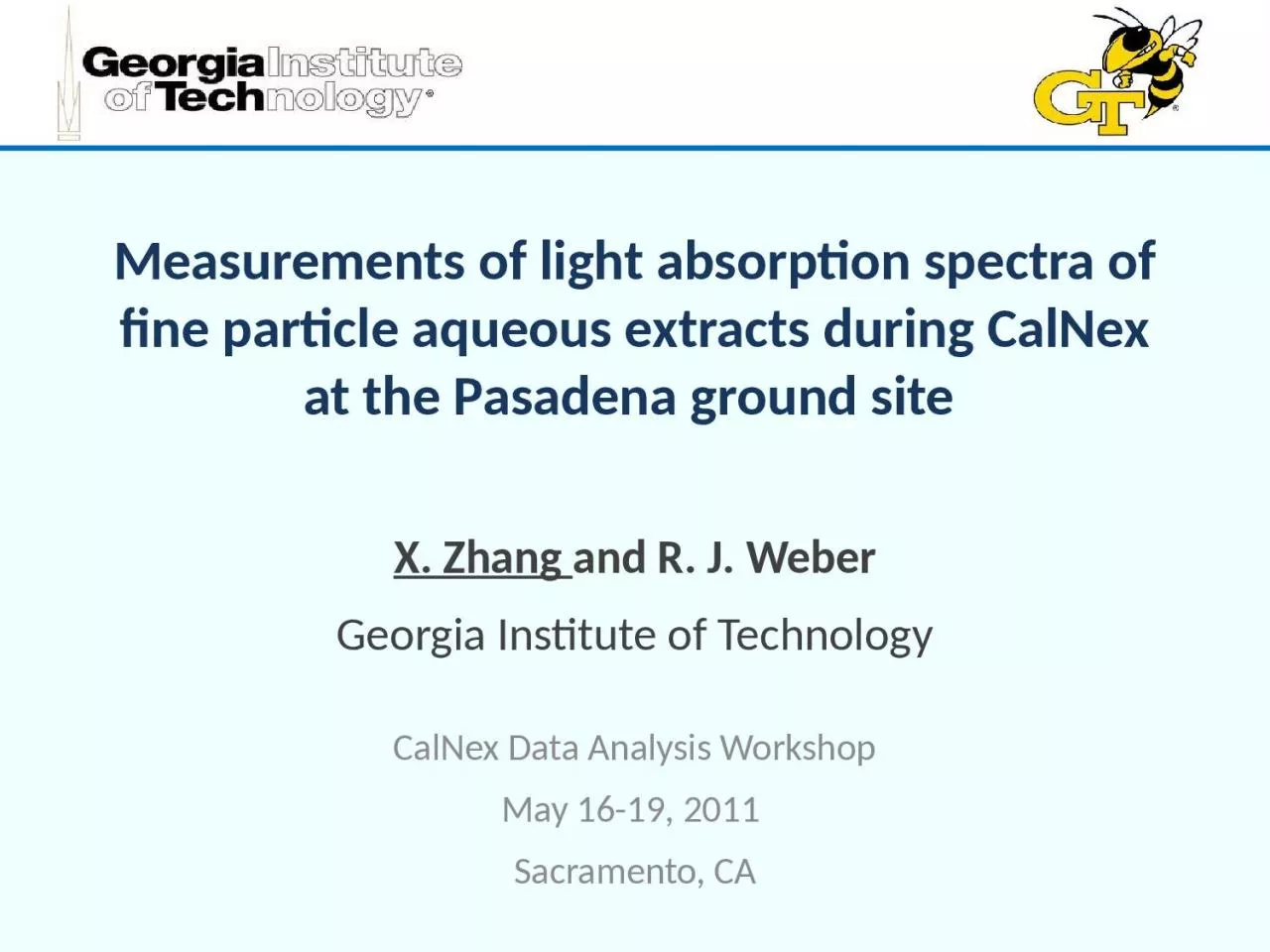

of fine particle aqueous extracts during CalNex at the Pasadena ground site X Zhang and R J Weber Georgia Institute of Technology CalNex Data Analysis Workshop May 1619 2011 ID: 999445
Download Presentation The PPT/PDF document "Measurements of light absorption spectr..." is the property of its rightful owner. Permission is granted to download and print the materials on this web site for personal, non-commercial use only, and to display it on your personal computer provided you do not modify the materials and that you retain all copyright notices contained in the materials. By downloading content from our website, you accept the terms of this agreement.
1. Measurements of light absorption spectra of fine particle aqueous extracts during CalNex at the Pasadena ground site X. Zhang and R. J. WeberGeorgia Institute of TechnologyCalNex Data Analysis WorkshopMay 16-19, 2011 Sacramento, CA
2. Real-time light absorption spectral measurement(Hecobian et al., 2010)Long Optical Path Spectrometry With Liquid Wave guides (LWCC)1 meter Waveguide Capillary Cell Complete absorption spectra (200 – 800nm) was saved every 15 min Absorption coefficients at selected wavelengths (365nm, 700nm) were saved every 60 secSimultaneous measurements of soluble particle absorption spectra and carbon mass
3. Choice of wavelength: λ = 365nmλ = 365nm : Absorption averaged between 360 and 370nmλ = 700nm: Reference wavelengthHULIS Soluble Brown Carbon, specifically associated with HULIS (Lukacs et al., 2007); Avoid interferes from other species: e.g. Nitrate;(Hoffer et al., 2006)NitrateBlank measurementλ = 700λ = 365Absorption coefficient at 365nm (Abs365)Absλ = (A λ – A700)VlVa · l· ln(10)Unit: m-1
4. Sources of brown carbon: PMF result on FRM filtersBiomass burning;Primary emissions from vehicle;SOA formation (WSOC/Oxalate);Major sources of Brown Carbon (Abs365) in the southeast:(Hecobian et al., 2010)PMF analysis on 900 FRM filters collected at 15 sites in SE USPossibly related to aqueous SOA formation/chemical aging – oxalate and brown carbon peak hours after WSOC peak on diurnal average from online dataset in Atlanta. Biomass BurningResidualRefractory MaterialWSOC/OxalateAmmonium Sulfate/WSOCMobile Sources
5. WSOC and brown carbon during CalNexCaltech site: Jun. 01 – Jun. 15Abs365WSOCRiverside campus: May. 17 – Jun. 14
6. CalNex: mass absorption efficiencyAbs365WSOCEC“primary”secondaryαabs = 0.71 m2/gMass absorption efficiency (αabs) ΔAbs365/ ΔWSOCSmall compared to αabs for soot ~ 7.5m2/g (Bond and Bergstrom, 2006)at 360-370nm
7. Mass absorption efficiency: LA compared with AtlantaAbs365WSOCECGatech campusin Atlanta, Aug. 2010primarysecondaryLA fresh secondary WSOC is much more light-absorbing than Atlanta Mass absorption efficiencyATL: αabs = 0.18 m2/gLA: αabs = 0.71 m2/gLA 4 x higherDAbs
8. Angström exponentWavelength dependence of the absorption coefficientαab = K · λ-ÅFor ambient aerosol Å ~1: black carbon (absorbs at all wavelength) Å ~2: ambient biomass burning aerosol (Kirchstetter et al., 2004) Å ~3.5: polluted region in China (Yang et al., 2009)Plot on Ln-Ln scaleSlope = -ÅFor liquid extracts (this study) Å ~7: water-soluble HULIS (Hoffer et al., 2006) Å ~7-16: smoldering smoke (Chen and Bond, 2010) Å ~7: fresh limonene SOA (Bones et al., 2010) Å ~4.7: aged limonene SOA (Bones et al., 2010) Å ~6-8: FRM filters in SE US (Hecobian et al., 2010)
9. Variation of Angström exponentExample: 6.3.2010 – high concentration of Abs365Å varies between 2 and 5.5, lower during daytime and higher at night; Å increased from “fresh” to “aged” SOA?Å derived from online measurement significantly lower than Å from filter-based measurement (discussed in the next slide);
10. Filter-based vs. online absorption measurementsPossible artifacts of filter-based brown carbon measurement: Storage: 1-yr in the freezer leading to changes? Extraction: extraction/sonication leading to degradation of larger chromophores which absorb light at higher wavelengths? (Sun et al., 2007) Time resolution: filter liquid extracts sit for 1-2 days before analysisComparing Absorption coefficient (Abs365) and Angström exponent Some underestimation of Abs365 by high-vol filter; Online and filter Å quite different; For filter less absorption at higher wavelengths;CalNex Hivol FilterCalNex Online
11. Summary and ImplicationsSummaryWhy care about Brown Carbon? Generally not thought to have effect on radiative forcing due to small mass absorption efficiency (Andreae & Gelencser, 2006), BUTSOA properties, source and evolution: - Component of fresh anthropogenic SOA (related to aromaticity?) (Sun et al., 2007), useful for contrasting SOA in different urban settings (e.g. LA vs ATL); - Dissolve in liquid droplets, affect cloud absorption (Mayol-Bracero et al., 2002) & useful to study heterogeneous processing;Major sources of brown carbon during CalNex is SOA formation and mobile emission ;Fresh LA WSOC is ~4 times more light-absorbing than fresh ATL WSOC, possibly due to a larger fraction of anthropogenic aerosol in LA;Angström exponents lower during daytime and higher morning and night (evidence for anthropogenic SOA evolution?);Filter-based measurement not consistent with online measurement (more experiments)Future work/collaboration Try to find correlation between brown carbon and specific SOA component?